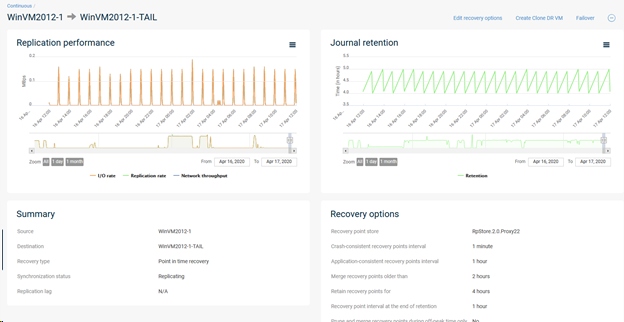From the Replication Monitor, you can see information about the replication pairs that are configured for continuous replication.
The monitor can show information for replicated VMs or for file system volumes.
Replication Pairs
The Continuous tab shows the following information:
-
Summary: General information about replication pairs that use different configuration options.
-
Synchronization status: Current status information for all replication pairs, such as Starting, Replicating, Stopped, or Not synced.
-
Replication pairs: Information for each replication pair.
From the list to the right of the Replication pairs heading, you can select All, FS - FS (for file system replication), or VM - VM (for VM replication).
For each pair, the following information appears:
-
Source: The source VM or file system volume.
-
Destination: The replicated VM or file system volume.
-
Endpoint: The type of replication (File System or Virtualization).
-
VM group: For virtualization pairs, the VM group for the source VM.
-
Replication group: The replication group where the replication pair is configured.
-
Recovery type: The type of recovery that is available at the destination site: Latest recovery (only the latest copy of the source) or Point in time recovery (multiple recovery points).
-
Synchronization status: Current status information for the replication pair, such as Starting, Replicating, Stopped, or Not synced.
-
Status description: Additional information for the synchronization status.
-
Replication lag: For pairs that are configured for point-in-time recovery, the delay in applying updates for recovery points.
-
Recovery point store: The store that records application-consistent recovery points (ACRPs) and associated updates as point-in-time recovery points for each replication pair.
-
Test failover status: Current status information for a test failover operation.
-
Test failover description: Additional information for test failover status.
-
Clone DR VM status: Current status information for a DR VM clone operation.
-
Clone DR VM description: Additional information for the clone status.
-
Test boot status: Current status information for a test boot operation.
-
Test boot description: Additional information for the test boot status.
-
Permanent boot status: Current status information for a permanent boot operation.
-
Permanent boot status description: Additional information for the permanent boot status.
-
Action: You can select the following options for a replication pair:
-
Start: Begin replication for a pair when replication is stopped.
-
Stop: Stop replication.
Note
If you stop replication, existing recovery points are discarded when you restart replication.
-
Suspend: Pause replication.
-
Resume: Continue a replication operation that was suspended.
-
Resync: Reapply updates from the source to the destination.
-
Create permanent boot (VM replication): Start the destination VM and keep it available for continued operation.
-
Create test boot (VM replication): Temporarily start the destination VM.
-
Create replica copy (file system replication): Create a replica copy to make volumes available on the destination computer for continued operation.
-
Edit recovery options: Change the options for recovery at the destination site.
-
Edit replication volume (file system replication): Modify the settings for volume replication from the source computer to the destination computer.
-
Delete pair: Remove the replication pair from the monitor and the replication group.
The destination VM or file system volume is not removed when you delete the replication pair.
-
-
Replication Pair Properties
You can click a replication pair to view detailed information for the pair.
The following information is included on the properties page for a replication pair:
-
Replication performance: This tile displays an interactive graphic that summarizes the I/O rate, replication rate, and network throughput for the replication pair. You can select a performance statistic to change the display, and select a point or a range on the graphic to examine statistics more closely.
-
Journal retention: This tile displays an interactive graphic that summarizes the journal retention for recovery points for the destination VM. You can select a point or a range on the graphic to examine statistics more closely.
-
Summary: This tile provides information about the replication pair.
-
Replication volumes: For file system replication, shows the mapping between source volumes and destination volumes.
-
Recovery options: For replication pairs that are configured for point-in-time recovery, this tile provides information about the configured options for recovery at the destination site.
-
Replica copy: For file system replication, shows information about replicated volumes at the destination computer.
-
Replication copy details: For VM replication, shows information about replication copies at the destination.
The following graphic is an example of the properties page for a virtual machine replication pair:
